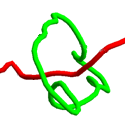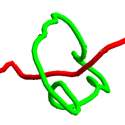Weaving a tangled web
iPod headphone wires, vortex lines in a superfluid, and cosmic-scale tendrils of matter in the evolving universe are very different objects, but they share some general topological properties. In particular, when each gets tangled up, they can be very resistant to being sorting out by simple transformations. Writing in Physical Review Letters, Kevin O’Holleran and Miles Padgett of the University of Glasgow and Mark Dennis of the University of Bristol, both in the UK, report their efforts to quantify and understand these kinds of rats-nest problems by examining the topology of the dark regions in a complex optical field.
The case they study is optical speckle, observed when coherent light bounces off a rough surface. O’Holleran, Padgett, and Dennis numerically simulated optical speckle by superposing random plane waves to form a complex electromagnetic field marked by labyrinthine regions of complete destructive interference. These nodal regions thread the entire field volume, creating tangled vortex lines and loops that the authors can map and analyze. Although previous work has quantified the degree to which lines are infinite or looped [1], the detailed topology and whether the nodal lines form knots and links has been unclear.
After 3000 hours on a processor cluster, the simulations produced data that enabled the authors to identify loops that were both threaded and unthreaded by vortex lines, as well as loops linked with other loops. Not surprisingly, larger loops were more likely to be threaded and linked than smaller loops, but the authors were able to fit this behavior to a scaling law that resembled similar expressions that apply to polymer chains. Such universal behavior should permit better understanding of topological scaling in a wide variety of systems. – David Voss
[1] K. O’Holleran, M. R. Dennis, F. Flossmann, and M. J. Padgett, Phys. Rev. Let. 100, 053902 (2008).





